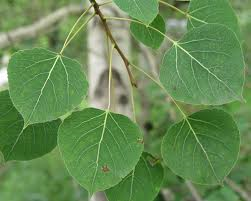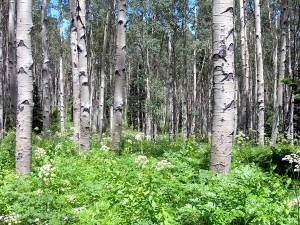My youngest sister tells me that once while camping or playing in the woods with the other kids she had a headache, and I apparently made her chew on aspen leaves as a remedy. I don’t remember this but it sounds like me; and it sounds even more like something I would have heard from my dad. I’ve chewed on the stuff before and it certainly tastes as bad as aspirin but we couldn’t remember how well it had worked. So I opted to do a little more research.
The tree commonly known as quaking aspen, Populus tremuloides, is a member of the poplar family that also includes willows and cottonwoods. Aspens are the most widely distributed native tree species in North America ranging from Alaska to Newfoundland and down the Rocky Mountains to Mexico. Utah and Colorado are home to the largest portion of the natural acreage of aspen trees in the world!
The leaves, buds, and inner bark of all the poplars contain varying amounts of populin (an obvious connection with the Populus genus) and salicin; a chemical that is very similar to aspirin, and may help reduce swelling. These chemicals add up to a natural form of our synthesized aspirin. The inner bark or leaves may be steeped in water for a pain-relieving tea. Historically they have also been used to treat burns, irritations, aches, and swollen joints. Aspen has also been used externally as a wash for inflammations, cuts scratches, wounds and burns, and bitter tisanes from bark and leaves have been used to treat mild urinary tract inflammations.
While aspens may not rival the cattail in variety as a food supply, they can provide a weary traveler with a bit of energy. The inner bark can be peeled and eaten although it is often quite bitter, and it is more palatable in the spring as with other wild edible plants like dandelions. This layer is the food transportation network for the tree and contains a fair amount of sugar. People often find deer and elk in search of winter browse have chewed the bark.
Jon



Leave a Reply